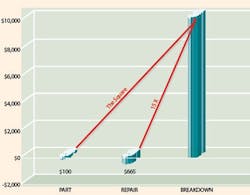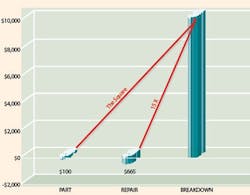Paying for Deferred Maintenance
When funding is limited, the list of postponed repairs and maintenance can become very long - very fast. Projects that are put on hold, repair that is neglected, and preventive maintenance that is ignored adds up to a costly and complex problem.
By definition, deferred maintenance is maintenance, system upgrades, or repairs that are deferred to a future budget cycle or postponed until funding becomes available. In order to address a deferred maintenance backlog, you must:
- Identify why projects, maintenance, and repairs have been deferred.
- Recognize and understand the scale of the problem.
- Quantify and communicate the financial impact of deferred maintenance.
- Prioritize projects and develop a strategy to secure adequate funding.
- Conduct preventive maintenance and complete repairs promptly to avoid backlog redevelopment.
Identify why projects, maintenance, and repairs have been deferred.
The primary reason that maintenance is deferred is because there simply isn’t the money to pay for it. If budget planning does not allocate adequate funding, or the budget is cut mid- year, an increase in deferred maintenance is inevitable. Additionally, if allocated funding is diverted to pay for emergencies and more visible projects, the risk of equipment failure and building deterioration increases.
Other reasons that maintenance is sometimes postponed:
- There is not enough manpower.
- Personnel do not have the expertise to perform maintenance.
- Repairs and upgrades can be addressed during a large-scale renovation or modernization that is already planned for the near future.
- Maintenance would interrupt or interfere with business operations (e.g. the scheduled shutdown of a manufacturing plant [for facility repairs] is cancelled because of the need to boost production).
- The parts are not readily available when needed. “The most difficult thing about doing maintenance is getting the right person with the right parts in front of the right machine when it’s available to be serviced,” explains David Tod Geaslin, principal, The Geaslin Group, Houston.
If you don’t want history to repeat itself, arm yourself with as much knowledge as possible about how and why maintenance has been deferred. In gaining a better understanding, you will become more capable of developing strategies to avoid many of these situations in the future.
Recognize and understand the scale of the problem.
Understanding the extent of the backlog is crucial to minimizing the volume of deferred maintenance and substantiating the need for funding. A facility assessment (often called a facility audit) can help eliminate any unknowns and provide a clearer picture of how big of a problem deferred maintenance has become. The assessment should evaluate the building’s condition and code compliance, as well as the performance and age of all finishes, systems, and equipment. The result is a building inventory and list of necessary projects, repairs, and system upgrades for each facility. When conducting an assessment, consult with the facilities professionals that are most familiar with each building and its particular systems. As an example, an HVAC technician that services the physical plant regularly can offer a wealth of information on system performance and repair history.
However, in some situations, it may be wise to employ the services of a third party to perform the assessment. “A maintenance team that works in a facility day in and day out may not see it deteriorating in front of them,” explains Paul J. Liesman, senior vice president, Syska Hennessy Group Inc., New York City.
“A mechanical engineer, electrical engineer, plumbing engineer, and sometimes a fire-protection engineer will review a set of drawings to familiarize themselves with the building. They go through checklists once they’re on-site and identify any deficiencies,” says James Sippel, vice president, Syska Hennessy Group Inc., Cambridge, MA. A detailed report, including the findings and a prioritized list of recommendations for repairs/maintenance, is provided.
Quantify and communicate the financial impact of deferred maintenance.
Unless you can calculate the consequences of deferred maintenance, your rationale for funding isn’t likely to be very persuasive. The most convincing argument against deferring maintenance is one that includes the following:
- Estimated risk potential. As a result of deferred maintenance, will liability and safety hazards increase, tenant satisfaction and employee productivity decrease, or business operations be affected?
- Subsequent escalation of costs. Use David Tod Geaslin’s Inverse-Square Rule for Deferred Maintenance Worksheet (below) to calculate and predict future expenses resulting from postponed maintenance.
- Historical data. To add credibility to your financial predictions, provide examples from the past that prove the significance of the long-term costs of deferred maintenance.
Make a business case and put the information in front of the people with the purse strings. “Then management acquires ownership of the problem, too - and the solution. You’ve told them. You’ve demonstrated the consequences of deferring maintenance. You even showed them,” says Geaslin.
Prioritize projects and develop a strategy to secure adequate funding.
With your list of projects in one hand and a financial analysis in the other, you may feel armed with enough information to begin making the case for funding. However, a bit more preparation is needed before you get on your soap box. It is important to prioritize deferred maintenance projects since it’s unlikely that enough funding will be provided to immediately erase the entire backlog in 1 year. Develop a set of criteria to help you prioritize projects. As an example, the facilities department at the University of California in Oakland, CA, organizes projects into the following three categories:
- Currently critical (projects that require immediate action to return a facility to normal operation, stop accelerated deterioration, or correct a cited safety hazard).
- Potentially critical (projects that will become critical within 1 year if not corrected expeditiously).
- Necessary, not yet critical (projects that require reasonably prompt attention to preclude predictable deterioration or potential downtime and the associated damage and higher costs if deferred further).
Don’t be surprised when some of the least expensive repairs surface at the top of the list. As you cull through the backlog, projects with immediate health- and safety-related ramifications or business-continuity implications should be categorized as “currently critical.” “Your ability to maintain the reliability of the building and its systems to support business needs is a priority,” says Liesman. Additional criteria might include the following: protecting the building envelope, increasing energy efficiency, updating aesthetics, and boosting employee productivity and tenant retention/attraction.
Even the best preparation and presentation skills may not garner the kind of money needed to complete all of the deferred maintenance projects that are classified as “potentially critical.” Look your list over closely: Any projects that reduce peak demand or increase energy efficiency may qualify for rebates offered by utility companies. “Sometimes, there are grants to upgrade the efficiency of lighting or heating and cooling systems through local power authorities,” Liesman explains. “Utilities may provide partial funding to have some of the systems upgraded - especially in the name of energy efficiency.”
Another alternative is to fund energy conservation measures and high-efficiency equipment through performance contracting. Energy Service Companies (ESCOs) can help businesses and institutions implement energy-efficiency retrofits without spending a dime from capital or operations budgets. In simple terms, the ESCO evaluates facilities and determines how energy efficiency can be improved. It then finances and installs new equipment, as well as measures and reports on the resulting energy cost savings. The money saved can fund additional improvements that will decrease the deferred maintenance backlog at an even faster rate.
Geaslin’s Inverse-Square Rule for Deferred Maintenance
If you defer maintenance, you can expect future expenses to be equal to or greater than the cost of the part squared or 15 times the total repair cost.
Conduct preventive maintenance and complete repairs promptly to avoid backlog redevelopment.
“Deferred maintenance accumulation is almost inevitable, even under the best circumstances. However, to prevent the accumulation, you’ve got to have an effective preventive maintenance program to minimize a facility’s rate of decay,” explains Liesman. Communicate the need for a gradual increase in maintenance budgets.
Additionally, at the onset of deterioration, action should be taken to implement a repair. “If you’ve decided to intervene early, you’re going to have a positive cash flow. You’ll start recouping [between] a 30:1 [and] 40:1 positive cash flow with every early intervention, and roughly 15:1 in maintenance manhours,” Geaslin says. The faster you intervene and conduct a repair, the better. “If the CEO and CFO are really creative, they will find a way to fund the repair of every maintenance event at the earliest practical moment after detection. Every other philosophy will produce a higher cost and, if a failure occurs, the cost will be 30-times the early intervention cost,” he adds.
Spend money now or spend more money later - once everyone understands the rapid escalation of costs, obtaining adequate funds should be easier. By making the business case for funding and proactively managing maintenance every day, you’re less likely to develop a deferred maintenance backlog that seems too overwhelming to overcome.
Jana J. Madsen ([email protected]) is managing editor at Buildings magazine.

